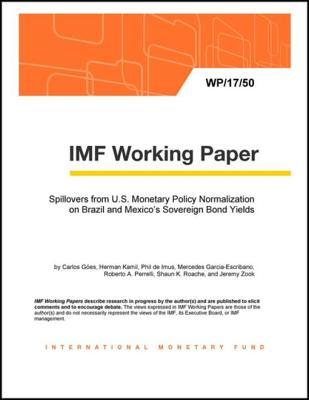Read Online Spillovers from U.S. Monetary Policy Normalization on Brazil and Mexico's Sovereign Bond Yields - Carlos Goes | PDF
Related searches:
Spillovers from U.S. Unconventional Monetary Policy and Its
Spillovers from U.S. Monetary Policy Normalization on Brazil and Mexico's Sovereign Bond Yields
US Monetary Policy and the Euro Area - DIW Berlin
US Monetary Policy and International Risk Spillovers - Hélène Rey
Spillovers from United States Monetary Policy on Emerging
Determinants of global spillovers from US monetary policy
Globaliztion and Monetary Policy Institute Working Paper No 331
Monetary Policy and Interest on Reserves Education St. Louis Fed
Uneven U.S. Recovery Tests Limits of Monetary and Fiscal Policies
Spillovers from the ECB's Non-standard Monetary Policy
Global Monetary Spillovers: Shocks and Vulnerabilities
Spillovers of Conventional and Unconventional Monetary Policy
Asset Price Spillovers from Unconventional Monetary Policy: A
Monetary Policy Spillovers and the Trilemma in the New Normal
4337 4772 3619 3810 3894 2305 3401 4431 3668 3456 4274 1208 1821 1176 750 3110 3548 879 1149
Jan 6, 2020 our research speaks directly to this, assessing the role of em prudential policies in the face of spillovers from us monetary policy.
Monetary policy to a panel of emerging-market economies (such as brazil, china, indonesia, india, malaysia, mexico, russia and south africa) using the local projection methods of jordà (2005). Monetary policy shock tends to depreciate the exchange rate, decrease gross domestic product, boost con-.
Monetary policy, leaf working paper series 19-02, university of lincoln, lincoln international business school, lincoln economics and finance research group (leaf).
Kolasa, m and g wesołowski (2020), “international spillovers of quantitative easing”, journal of international economics. Monetary policy and macroeconomic fluctuationsin emerging markets”, journal of monetary economics 54(8): 2512-2520.
Monetary policy affects variables that are crucial for spillovers over time • two-country nk dsge model is then used to analyse why the effects have changed over time by the estimation of the key structural parameters: • exchange rate pass-through • price stickiness.
Read next → monetary policy a new look at central bank independence.
While emerging market monetary policy independence occupies a middle ground. All the correlations fluctuate, but experience two pronounced dips in recent years, one in 2005 and the other at the time of the global financial crisis.
International transmission of us monetary policy occurs through.
Monetary policy announcements (in the originator country) may reveal new information on economic conditions in that country, as suggested by campbell et al (2012) and nakamura and steinsson (2018). This may in turn lead investors to update their expectations of macro conditions in the recipient country due to the various economic linkages.
In this paper we investigate the effects of united states and japanese monetary policy shocks on the asset markets of both economies. Understanding the impact of monetary policy shocks, whether domestically generated or from foreign monetary policy spillovers, is crucial for central banks because changes in interest rates, exchange rates, and asset prices affect the decisions of firms.
Dubbed spillovers—is hotly debated in global and national policy circles. Resorted to unconventional monetary policy, spillovers on asset prices and capital flows were significant, though remained smaller in countries with better fundamentals. This was not because monetary policy shocks changed (in size, sign or impact on stance).
May 29, 2019 in the us, japan, the eurozone, and the uk, sovereign rates fell as government debt rose.
But the focus on the monetary domain could distract us from developments in the fiscal sphere. When a country becomes too indebted, for instance, the resulting shock from bankruptcy can be extremely serious. These four considerations suggest that concerns about possible spillovers of monetary policy should not be overplayed.
Growth, monetary and fiscal policies, and uncertainty in its financial markets and economic policies.
Monetary policy on the real and nomi-nal treasury yields over a period that includes both the conventional and unconventional policy regimes.
Feb 9, 2021 the fed's decisions to hold rates near zero and pump money into the economy is boosting the stock market.
Finally, the finding that the global spillovers from us monetary policy are very large is in line with the hypothesis of a global financial cycle driven by financial conditions in the centre economy, and therefore begs the question of whether domestic monetary policy in non-us economies has been undermined by financial globalisation (georgiadis.
Keywords: structural dynamic factor model; sign restrictions; monetary policy.
Working paper 26297, national bureau of economic research, september 2019. Rounding the corners of the policy trilemma: sources of monetary policy autonomy.
We study spillover effects of us uncertainty fluctuations using panel data from fifteen emerging market economies (emes).
Dec 7, 2020 the federal reserve, america's central bank, is responsible for conducting monetary policy and controlling the money supply.
Abstract: the recent era of globalization has witnessed growing cross-country trade integration as firms’ production chains have spread across the world, and with stock market returns becoming more correlated across countries.
The notion that ( expan- sionary) us monetary policy plays a role in driving capital flows to emes.
Monetary policy spillovers from advanced economies into international asset markets have received renewed attention in the post-crisis period. This paper estimates the impact of us monetary policy shocks into international bond yields in a broad sample of developed and emerging market economies, and provides evidence with a view to uncovering.
This short video describes the use of the interest rate on bank reserves as a tool of monetary policy.
Monetary policy to in⁄ation targeting and exchange rate targeting emerging economies. The second contribution to the existing empirical literature is that the paper provides an empirical investigation of the dornbusch (1976) overshooting hypothesis in the context of emerging economies.

Post Your Comments: